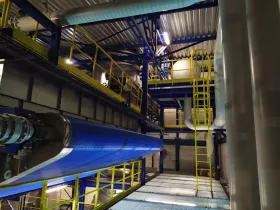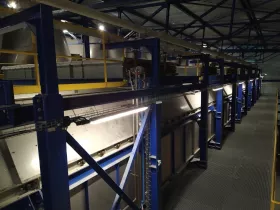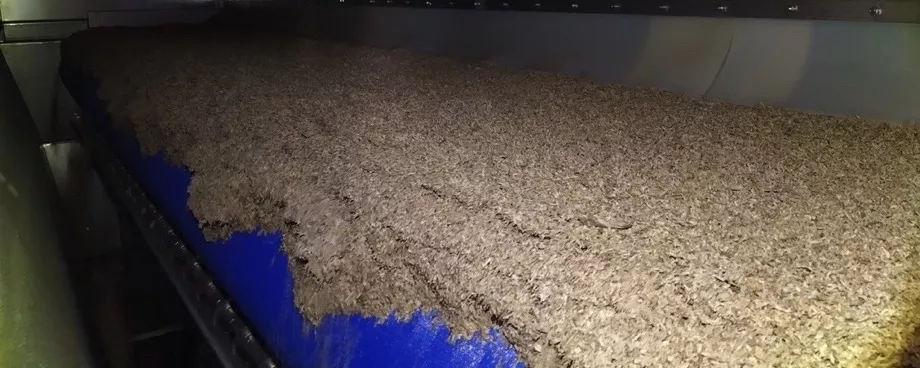The technological Process
The technological process is based on the use of the convective drying method, i.e. blowing heated air over the product. The difference in temperature and humidity between the air and the product, consequently reduces the product's moisture level (warm dry air - cold, moist material). The air that is taken from the atmosphere, passes through air heaters where it is heated to a pre-set temperature. Then it passes through the layer of material, removing moisture, and is further extracted and ejected into the atmosphere through ducts connecting the dryers with fans. The entire system operates under negative pressure.
Description of the Device

The belt dryer for beet pulp is composed of three levels - belts. The chamber of each belt is divided into segments; each segment is equipped with air heaters, whereby for the first and second belt (top and middle) the air is heated by glycol heaters only, while the third belt (bottom) is composed of two segments with air heated by glycol heaters and four segments heated by glycol-steam heaters. Each segment is equipped with an exhaust fan. The outlets from the fans - three in each case – are vertically connected to form common air discharge ducts. The belts are equipped with product spreading elements - spreaders, cleaning brushes and guidance systems. Furthermore, each belt has a washing system consisting of washing nozzles. The heating medium - glycol (used due to the possibility of the heaters freezing during the winter period) - is heated by the heat received from the supplied water (barometric water, ammonia water and water from the cleaning station) through a system of three plate heat exchangers. Glycol is distributed through pipelines to the individual heaters by a common pump. In front of the dryer there is a system of screw conveyors delivering wet sugar beet pulp to the dryer. The outlet from the dryer is terminated by a screw conveyor with two independently driven shafts, which makes the separation of the dried sugar beet pulp into two streams feeding the briquetting lines possible.
Description of the Design

The sugar beet pulp dryer is a compact structure consisting of many sub-assemblies. The backbone of the whole installation is the support structure for the process equipment, which also fulfils the functions of the service and maintenance platform. The structural elements of the device that come into contact with the product are made of AISI304 stainless steel - drying chambers, fans and air ducts. The remaining elements, i.e. the support structure, pipelines, tanks, etc. that are not in contact with the product are made of painted carbon steel Due to the different drying air temperatures, the dryers are divided into two segments: - Low-temperature drying segments - this is the part of the dryer where only waste heat will be used to heat the air. - High-temperature drying segment - this is the part of the dryer where it is possible to use waste heat with higher parameters to heat the air.
Process Parameters
- Dryer product inlet - Quantity - 35.6t/h - Moisture content in wet sugar beet pulp - 70%.
- Dryer product outlet - Quantity - 12.0t/h - Moisture content in dry sugar beet pulp - 11%
- Installed thermal power: approx. 30 MW (waste heat).
Summary
Installing a belt dryer that uses waste heat in a sugar factory significantly improves the technical and economic parameters of an enterprise and allows a feed product with better quality properties to be produced.
Visit MYSAK at POWTECH 2023, Hall 1, Stand 544
■







